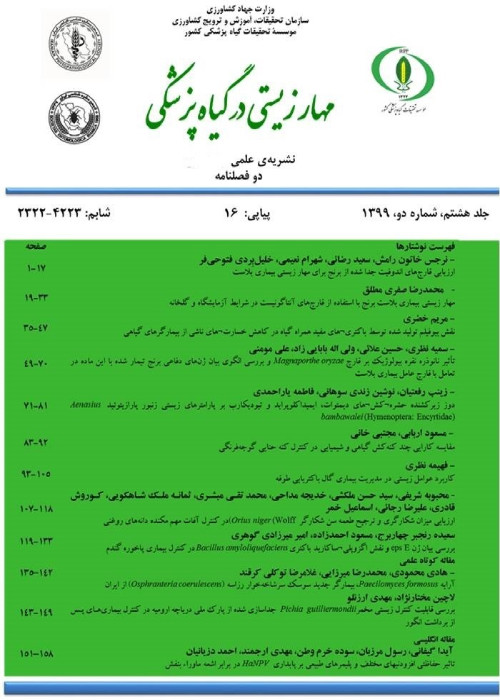An investigation on the biology and efficiency of Trichogramma spp. on the egg of Pieris rapae under laboratory conditions
Author(s):
Abstract:
Reports have proved that Pieris rapae with 40% annual damage is the second destructive pest of cabbage after Plutella xylostella. As there are frequent chemical spray operations against the pest and due to environmental and public health hazards, an investigation was carried out to introduce a species of Trichogramma for future bio-control programs in cabbage. All experiments were carried out at 25± 0.5°C, 60± 10% RH and 16:8 L: D. Based on field observations and greenhouse rearing of P. rapae, it was revealed that egg incubation took 5-7 days. Five larval instars development enlonged 20-30 days and pupal stage period was about 6-9 days. Longevity of male and female butterflies was 7 and 10 days, respectively.Preliminary results demonstrated that immature stage development took 10.43±0.15 and 10.07±0.11 days and 10.48±0.099 and 10.17±0.093 days for female and male individuals of T. brassicae and T. evanescens, respectively. Moreover, female and male longevity was 2.03±0.20 and 1.40±0.24 days and 1.68±0.16 and 1.85±0.40 days for both species, respectively. Further analysis showed that gross and net fecundity and fertility for T. brassicae and T. evanescens were 51.92 and 39.46 eggs/ female and 83.04 and 77.19 eggs/female, respectively. Similarly, mean age net fecundity and fertility in the same order species were 0.36 and 0.39 days and 0.162 and 0.162 days, respectively. Data analysis on reproductive attributes revealed thegross and net reproductive rates for T. brassicae and T. evanescens on eggs of P. rapae obtained as 22.77 female egg/female and 12.95 female progeny/female and 66.14 female egg/female and 29.32 female progeny/female, respectively. Similarly, intrinsic (rm) and finite (l) rates of increase were calculated as 0.238 (day-1) and 1.269 female progeny/day and 0.305 (day -1) and 1.357 female progeny/day for T. brassicae and T. evanescens, respectively. Doubling times were 2.90 and 2.265 days and generation times were calculated as 10.74 and 11.04 days for the same species, respectively. Also results proved that in both parasitoids immature stages accounted for about 98 percent and adults for 2% of the population in the age distribution of the stable population. For final conclusion, it could be said that almost all T. evanescens life history parameters on eggs of P. rapae were superior compared to those of T. brassicae. Therefore, it would be a potential candidate for future bio-control programs for small cabbage butterfly.
Keywords:
Language:
Persian
Published:
BioControl in Plant Protection, Volume:4 Issue: 2, 2017
Pages:
39 to 53
https://magiran.com/p1728997
دانلود و مطالعه متن این مقاله با یکی از روشهای زیر امکان پذیر است:
اشتراک شخصی
با عضویت و پرداخت آنلاین حق اشتراک یکساله به مبلغ 1,390,000ريال میتوانید 70 عنوان مطلب دانلود کنید!
اشتراک سازمانی
به کتابخانه دانشگاه یا محل کار خود پیشنهاد کنید تا اشتراک سازمانی این پایگاه را برای دسترسی نامحدود همه کاربران به متن مطالب تهیه نمایند!
توجه!
- حق عضویت دریافتی صرف حمایت از نشریات عضو و نگهداری، تکمیل و توسعه مگیران میشود.
- پرداخت حق اشتراک و دانلود مقالات اجازه بازنشر آن در سایر رسانههای چاپی و دیجیتال را به کاربر نمیدهد.
In order to view content subscription is required
Personal subscription
Subscribe magiran.com for 70 € euros via PayPal and download 70 articles during a year.
Organization subscription
Please contact us to subscribe your university or library for unlimited access!


